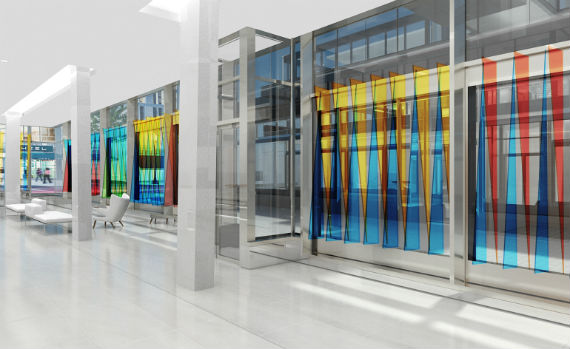Cruz control: Carlos Cruz-Diez redefines colour with new work in Washington DC
(01.2016)
Carlos Cruz-Diez has created a permanent installation in Washington DC, in the lobby of law firm Covington at Foster + Partners' CityCenter
At age 92, the master of kinetic art, Carlos Cruz-Diez, is back in vogue, and has recently unveiled a major permanent installation in Washington DC, one of the largest site-specific works the Franco-Venezuelan artist has done in North America.

© Photo: Hendrich Blessing
The location is CityCenter, a new development designed by Foster + Partners covering six city blocks, including apartments, offices, retail and restaurants, as well as a hotel by Herzog & de Meuron. Debra Lehman Smith, co-founder of LSM architecture and interior design studio, calls it the ‘new heart of DC’.
One of her clients, the law firm Covington, is CityCenter’s biggest tenant, occupying 80 per cent of the two office buildings, including a glass-walled lobby on the ground floor. Covington wanted to commission a permanent artwork to anchor the space, so Lehman Smith, who designed 450,000 sq ft across 11 floors for the firm, came up with a 12-strong shortlist of names, with long-time collaborator, art consultant Lisa Austin.
By spring 2014, they agreed that Cruz-Diez was the ideal candidate, an internationally renowned artist whose work with colour and op art has influenced generations. ‘It was his understanding of colour theory and transparency – it just happened to be the perfect corner for his pieces,’ says Lehman Smith.
Today, if you walk by Covington’s offices on Tenth Street, you’ll find vertical Plexiglas fins in alternating colours installed along two corner glass walls – works Cruz-Diez calls Transchromie. Sunlight entering the windows casts a temporary carpet of colour on the floor inside. Hanging on interior walls at either end of the Transchromie are two of the artist’s Physichromies, each a large aluminium base covered with parallel Plexiglas fins, which are inkjet-printed to portray overlapping rectangles of different colours. The installation bathes the viewer in coloured light, and when the spectator moves their standpoint, the piece changes completely.
Talking from his part-time residence in Panama, Cruz-Diez says, ‘It was an enormous pleasure to intervene in a space by Foster + Partners, where the light offered me the opportunity to create one spectacle during the day and another at night. During the day, from the inside, the brightness of the site allowed me to reveal the subtractive effect of the transparent colours, and at nighttime, the illumination from the interior would project a spectacle into the space of the city.’
Born in Caracas in 1923, the artist has spent most of his career in Paris experimenting with colour and how it interacts with light and the viewer’s movements. He sees colour as an experience in and of itself, divorced from medium. ‘This is a discourse I have been forming since 1954,’ he explains. ‘I have had a hard time making myself understood because the important thing in painting has been drawing, the subject matter, the perspective and composition. Colour was an accessory, something banal, an anecdote of the form.’
With his posture unbowed and his pink shirt as luminous as his artworks, Cruz-Diez looks decades younger than his years. He has never stopped creating, though he tends to be selective. ‘We enticed him with the space,’ Austin admits. ‘This is not just a corporate space – everyone in Washington is going to walk by.’
The commission was also an important commitment for Covington. So much so, the firm’s chairman, Timothy Hester, flew to Houston, where the Cruz-Diez Foundation is located, for a day. Hester recalls, ‘It was hard to understand the scale and energy of Cruz-Diez’s work simply from photographs, because movement is such an important element of experiencing this work. Once we saw it in person, it was clear that the paintings and installation would be a powerful element of our new space.’
Most passers-by will admire the installation’s beauty, whether or not they appreciate its significance or the artist’s place in art history. Examples of Cruz-Diez’s groundbreaking explorations of colour and light are in the collections of MoMA, the Tate and the Centre Pompidou, but he had fallen into relative obscurity. ‘Artists like Cruz-Diez, they’re famous early in their career, but the market is cruel,’ Austin notes.
Now, though, the artist’s auction prices have started to soar. ‘I am pleasantly surprised by the audience that my work has found,’ he says. ‘I had the impression I was living in a society full of blind people. I think it was the artist Raymond Duchamp-Villon, who said that the hardest thing for any artist is the first 75 years.’
Source: Wallpaper - Amy Serafin
